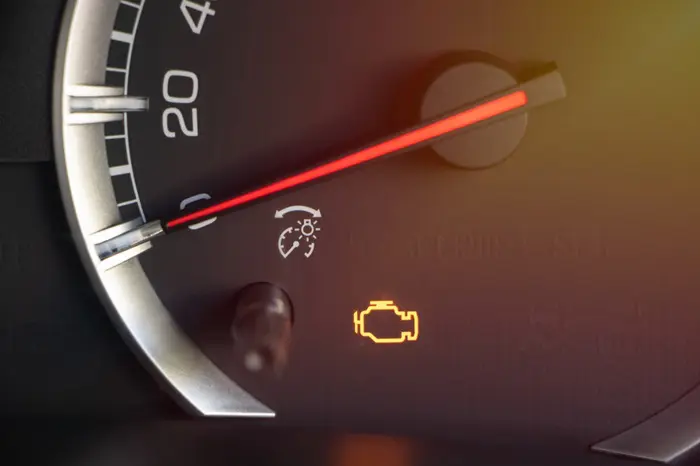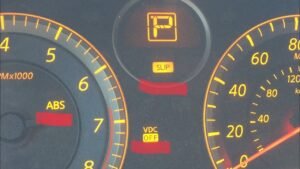Few things cause more frustration for car owners than seeing the check engine light turn on and off unexpectedly. One moment, everything seems fine, and then suddenly, the warning light appears—only to disappear again a short while later.
This unpredictable behavior can leave you wondering if there’s a real issue with your car or if it’s just a glitch.
Modern vehicles are equipped with onboard diagnostics (OBD) systems designed to monitor the performance of various components, including the engine, fuel system, emissions, and sensors.
When something isn’t functioning properly, the system triggers the check engine light to alert the driver. However, when the light turns off by itself, it often indicates an intermittent issue or a minor problem that the system no longer detects.
In this guide, we’ll explore the most common reasons why the check engine light turns on and off, whether you should be concerned, and how to properly diagnose and fix the issue.
Why Does the Check Engine Light Turn On and Off?
The check engine light isn’t just a simple warning—it’s a signal from your car’s computer (ECM or ECU) that something isn’t working as expected.
However, not all issues are constant. Some problems come and go, which is why the light may turn off by itself. Here are the most common reasons for this behavior:
1. Loose or Faulty Gas Cap
A loose gas cap is one of the simplest yet most overlooked reasons for a check engine light. The fuel system in modern vehicles is sealed to prevent vapor leaks. If the gas cap isn’t tightened properly or is damaged, it can cause a small leak, triggering the light.
🔧 What to Do:
- Check the gas cap and ensure it’s tightly secured.
- If the cap appears cracked or worn, replace it with a new one.
- Drive for a while to see if the light turns off after the system resets.
2. Intermittent Sensor Malfunction
Modern vehicles rely on multiple sensors to monitor engine performance. Sometimes, a sensor may send incorrect data to the car’s computer due to temporary issues like dirt buildup, minor electrical glitches, or fluctuating readings.
🔧 What to Do:
- Use an OBD2 scanner to check for stored error codes, even if the light turns off.
- Clean sensors like the oxygen sensor or mass airflow sensor if they appear dirty.
- If the issue persists, consider replacing the faulty sensor.
3. Minor Engine Misfires
A small misfire occurs when one or more cylinders fail to ignite fuel properly. This could be due to bad spark plugs, ignition coils, or dirty fuel injectors. In some cases, the misfire might be so minor that the system corrects itself, causing the light to turn off.
🔧 What to Do:
- Check spark plugs and replace them if they appear worn.
- Inspect ignition coils for cracks or signs of failure.
- Use a fuel system cleaner to remove carbon deposits from injectors.
4. Fluctuating Emission Readings
Your vehicle’s emissions system constantly monitors harmful pollutants. If the readings temporarily exceed the acceptable limit, the check engine light may turn on. However, if the system detects normal readings on the next drive cycle, it may turn off.
🔧 What to Do:
- Ensure you’re using high-quality fuel.
- Drive at highway speeds occasionally to allow the catalytic converter to function properly.
- If the problem returns, get an OBD2 scan to check for emission-related codes.
5. Weak or Failing Battery
A weak battery can sometimes cause erratic electrical behavior, including intermittent check engine light activation. If the battery voltage drops too low, the car’s computer may momentarily detect faults that disappear once voltage stabilizes.
🔧 What to Do:
- Test the battery with a voltmeter (should read at least 12.6V when off, and above 13.7V when running).
- Clean corroded terminals and ensure tight connections.
- If the battery is over 3-5 years old, consider replacing it.
Should You Be Concerned?
If the check engine light turns on and off occasionally, you may be dealing with a minor or intermittent issue. However, it’s still important to investigate further. Here’s how to assess the situation:
🔹 If the Light Turns Off by Itself and Stays Off:
- Likely a minor issue that has been resolved (e.g., loose gas cap).
- Monitor your car’s performance for any unusual behavior.
🔹 If the Light Turns Off But Comes Back Later:
- This suggests an ongoing intermittent issue (e.g., sensor malfunction or small misfire).
- It’s best to scan for error codes even if the light is off.
🔹 If the Light Flashes and Then Goes Off:
- A flashing check engine light usually indicates a serious misfire.
- Even if it turns off, it’s crucial to get it checked immediately.
How to Diagnose the Issue
If you’re unsure why your check engine light is turning on and off, follow these steps:
Step 1: Scan for Error Codes
Even if the check engine light turns off, the car’s computer stores past error codes that can provide insight into the problem.
🔧 How to Scan for Codes:
- Plug in an OBD2 scanner (available online or at auto parts stores).
- Check for pending or stored codes in the system.
- Look up the code meanings to determine the potential issue.
Step 2: Inspect Common Problem Areas
Check these common sources of intermittent check engine light issues:
✅ Gas Cap – Make sure it’s tight and in good condition.
✅ Battery Voltage – Test the battery and alternator for proper voltage.
✅ Sensors – Clean or inspect the oxygen sensor, mass airflow sensor, and throttle position sensor.
✅ Spark Plugs & Ignition Coils – Worn plugs can cause random misfires.
Step 3: Monitor for Changes
If the check engine light has turned off, take these precautions:
🔹 Drive normally and observe performance (any hesitation, stalling, or unusual noises?).
🔹 If the light stays off and the car runs fine, it may have been a temporary issue.
🔹 If the light returns, scan for codes again and take action accordingly.
Final Thoughts
A check engine light that turns on and off can be frustrating, but it often points to intermittent or minor issues. The best approach is to scan for error codes, check common problem areas, and monitor your vehicle’s performance.
In most cases, simple maintenance—like tightening a gas cap, replacing spark plugs, or cleaning a sensor—can resolve the issue. However, if the light keeps coming back, a deeper inspection is necessary.
Taking a proactive approach can prevent small issues from turning into major repairs, ensuring your car stays in optimal condition.





